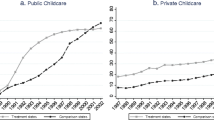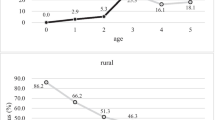Abstract
Using data from a recent national survey of approximately 20,000 Chinese middle school students, we tested the difference in cognitive development between only-children and children with siblings using non-parametric matching method. We took advantage of the massive increase in involuntary only-child families in China under the one-child family planning policy (1979–2015) to reduce the bias introduced by the otherwise pervasive human tendency to avoid having only one child. Our average treatment effect for the treated estimates indicates no significant cognitive difference between only-children and children with siblings. Further subgroup analyses, however, suggest that such average effect estimates can conceal important population heterogeneities because the only-child effect on cognitive development changes drastically between subgroups of the same population. Among other potential moderating factors, birth order and gender play particularly important roles in this process.



Similar content being viewed by others
Notes
The CEPS data, including the cognitive test information, and complete questionnaire and design documents are publicly available from the project web site (http://chinaeps.org/).
For symmetric and unimodal distribution, 95% HDI coincides with 95% confidence interval (CI). However, with non-unimodal or non-symmetric distribution, HDI has better theoretical properties than CI (Hyndman 1996).
References
Akaike, H. (1973). Information theory as an extension of the maximum likelihood principle. In B. N. Petrov & F. Csaki (Eds.), Second international symposium on information theory (pp. 267–281). Budapest: Akademiai Kiado.
Anastasi, A. (1956). Intelligence and family size. Psychological Bulletin, 53(3), 187–209.
Angrist, J., Lavy, V., & Schlosser, A. (2010). Multiple experiments for the causal link between the quantity and quality of children. Journal of Labor Economics, 28(4), 773–824.
Åslund, O., & Grönqvist, H. (2010). Family size and child outcomes: Is there really no trade-off? Labour Economics, 17(1), 130–139.
Becker, G. S., & Tomes, N. (1976). Child endowments and the quantity and quality of children. Journal of Political Economy, 84(4), S143–S162.
Belmont, L., & Marolla, F. A. (1973). Birth order, family size, and intelligence a study of a total population of 19-year-old men born in the Netherlands is presented. Science, 182(4117), 1096–1101.
Black, S. E., Devereux, P. J., & Salvanes, K. G. (2010). Small family, smart family? Family size and the IQ scores of young men. Journal of Human Resources, 45(1), 33–58.
Blake, J. (1981a). The only child in America: Prejudice versus performance. Population and Development Review, 7(1), 43–54.
Blake, J. (1981b). Family size and the quality of children. Demography, 18(4), 421–442.
Blake, J. (1989). Family size and achievement. Los Angeles, CA: University of California Press.
Cáceres-Delpiano, J. (2006). The impacts of family size on investment in child quality. Journal of Human Resources, 41(4), 738–754.
De Ayala, R. J. (2013). Theory and practice of item response theory. New York: Guilford Publications.
Dumont, A. (1890). Civilization et depopulation. Paris: LeCronsier et Babe.
Dunning, T. (2012). Natural experiments in the social sciences: A design-based approach. Cambridge: Cambridge University Press.
Feeney, G., & Feng, W. (1993). Parity progression and birth intervals in China: The influence of policy in hastening fertility decline. Population and Development Review, 19(1), 61–101.
Feeney, G., Wang, F., Zhou, M., & Xiao, B. (1989). Recent fertility dynamics in China: Results from the 1987 one percent population survey. Population and Development Review, 15(2), 297–322.
Feng, X. (2006). Chinese only-children: Size and variations. Theory Monthly, 4, 5–10.
Fitzsimons, E., & Malde, B. (2014). Empirically probing the quantity-quality model. Journal of Population Economics, 27(1), 33–68.
Galton, F. (1874). English men of science: Their nature and nurture. London: MacMillan.
Greenhalgh, S. (2003). Science, modernity, and the making of china’s one-child policy. Population and Development Review, 29(2), 163–196.
Gu, B., Wang, F., Guo, Z., & Zhang, E. (2007). China’s local and national fertility policies at the end of the twentieth century. Population and Development Review, 33(1), 129–148.
Guo, G., & VanWey, L. K. (1999). Sibship size and intellectual development: Is the relationship causal? American Sociological Review, 64(2), 169–187.
Gupta, M. D., Zhenghua, J., Bobua, L., Zbenming, X., & Hwa-Ok, B. (2003). Why is son preference so persistent in East and South Asia? The Journal of Development Studies, 40(2), 153–187.
Hagewen, K. J., & Morgan, S. P. (2005). Intended and ideal family size in the united states, 1970–2002. Population and Development Review, 31(3), 507–527.
Hanushek, E. A. (1992). The trade-off between child quantity and quality. Journal of Political Economy, 100(1), 84–117.
Ho, D. E., Imai, K., King, G., & Stuart, E. A. (2007). Matching as nonparametric preprocessing for reducing model dependence in parametric causal inference. Political Analysis, 15(3), 199–236.
Hyndman, R. J. (1996). Computing and graphing highest density regions. The American Statistician, 50(2), 120–126.
Iacus, S., King, G., & Porro, G. (2011a). Causal inference without balance checking: Coarsened exact matching. Political Analysis, 20(1), 1–24.
Iacus, S., King, G., & Porro, G. (2011b). Multivariate matching methods that are monotonic imbalance bounding. Journal of the American Statistical Association, 106(493), 345–361.
King, G., Tomz, M., & Wittenberg, J. (2000). Making the most of statistical analyses: Improving interpretation and presentation. American Journal of Political Science, 44(2), 341–355.
Lee, J. Z., & Wang, F. (2001). One quarter of humanity: Malthusian mythology and chinese realities, 1700–2000. Cambridge, MA: Harvard University Press.
Mottus, R., Indus, K., & Allik, J. (2008). Accuracy of only children stereotype. Journal of Research in Personality, 42(4), 1047–1052.
Nisbet, J., & Entwistle, N. (1967). Intelligence and family size, 1949–1965. British Journal of Educational Psychology, 37(2), 188–193.
Polit, D. F., & Falbo, T. (1988). The intellectual achievement of only children. Journal of Biosocial Science, 20(03), 275–286.
Short, S. E., & Zhai, F. (1998). Looking locally at China’s one-child policy. Studies in Family Planning, 29(4), 373–387.
Sobotka, T., & Beaujouan, É. (2014). Two is best? The persistence of a two-child family ideal in Europe. Population and Development Review, 40(3), 391–419.
Tsui, M., & Rich, L. (2002). The only child and educational opportunity for girls in urban china. Gender & Society, 16(1), 74–92.
Veenhoven, R., & Verkuyten, M. (1989). The well-being of only children. Adolescence: An International Quarterly Devoted to the Physiological, Psychological, Psychiatric, Sociological, and Educational Aspects of the Second Decade of Human Life, 24(93), 155–166.
Wang, W., & Li, P. (2015). Psychometric report for the junior high student cognitive ability tests of CEPS baseline wave (technical report). Beijing: National Survey Research Center, Renmin University of China. www.chinaeducationpanelsurvey.org/assets/admin/org/ueditor/php/upload/20151222/14507142239451.pdf.
Yang, M., Tam, T., & Huang, M.-H. (2003). Psychometric report for the ability tests of TEPS 2001. Taipei: Center for Survey Research, Academia Sinica. Taipei: Center for Survey Research, Academia Sinica.
Zajonc, R. B., & Markus, G. B. (1975). Birth order and intellectual development. Psychological Review, 82(1), 74–88.
Author information
Authors and Affiliations
Corresponding author
Additional information
Publisher's Note
Springer Nature remains neutral with regard to jurisdictional claims in published maps and institutional affiliations.
Appendix
Appendix
See Tables 8, 9, 10, 11, 12 and 13.
Rights and permissions
About this article
Cite this article
Song, S., Wang, W. Testing the Only-Child Advantage in Cognitive Development in the Context of China’s One-Child Policy. Popul Res Policy Rev 38, 841–867 (2019). https://doi.org/10.1007/s11113-019-09556-9
Received:
Accepted:
Published:
Issue Date:
DOI: https://doi.org/10.1007/s11113-019-09556-9




